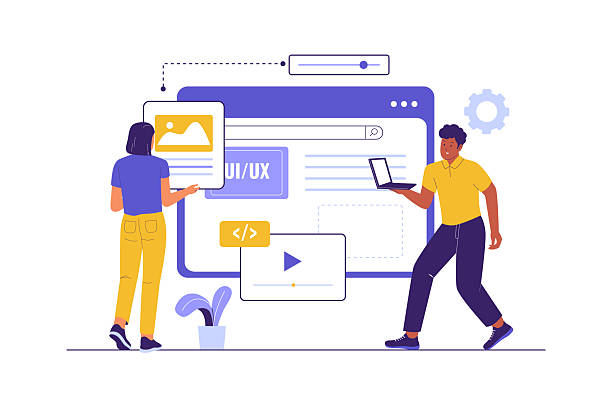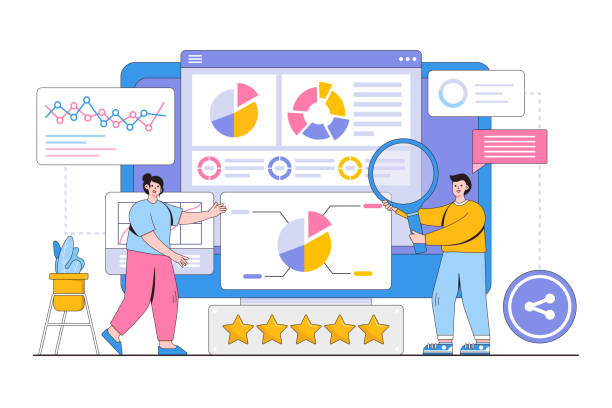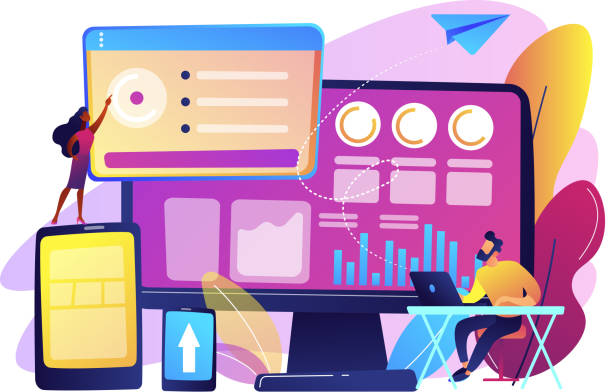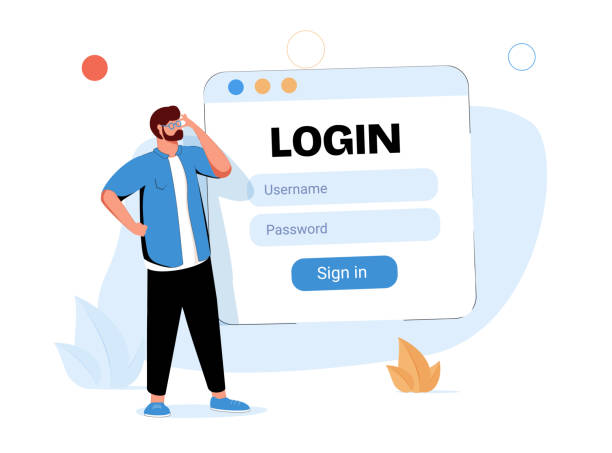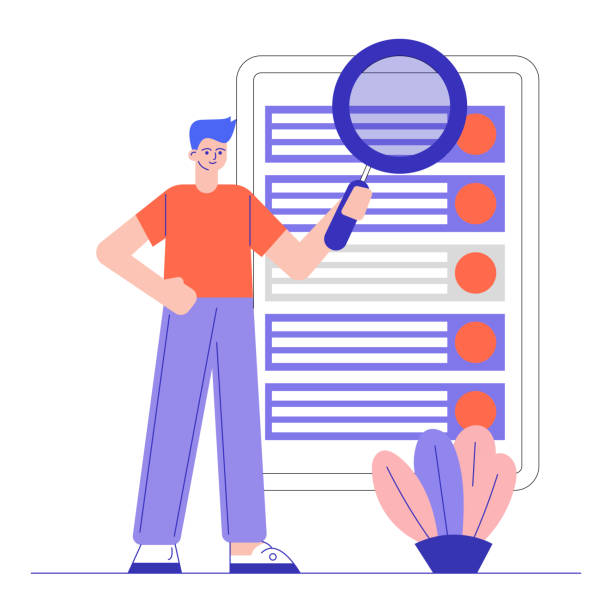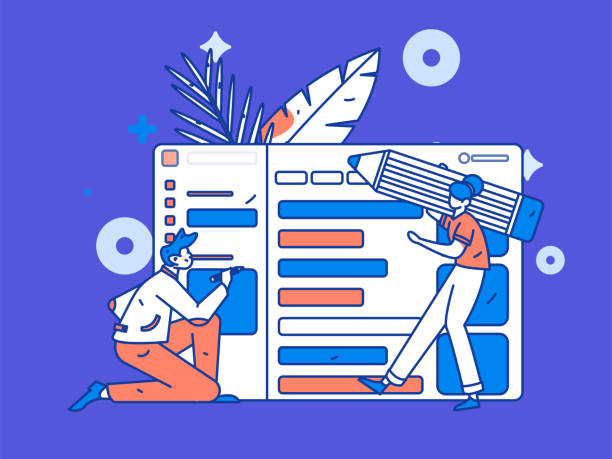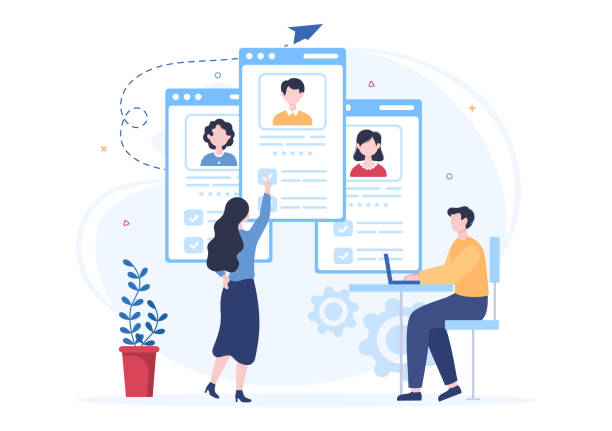Introduction to SEO-Optimized Website Design: Why is it Important?
In today’s highly competitive world, simply having a website is not enough; your website needs to be seen.
This is where the concept of #SEO_optimized_website_design comes in.
SEO-optimized website design means building a website that is not only attractive and functional for users, but also optimized for search engines like Google.
This optimization includes a series of technical and content-related actions aimed at ranking your website high in search results.
With a higher ranking, your website attracts more traffic, and this traffic can ultimately lead to increased sales or the achievement of your other goals.
This section, in an explanatory and educational manner, helps you gain a deeper understanding of the importance of this approach.
Without a strong SEO strategy, even the best products or services might get lost in the sea of online information.
Therefore, investing in SEO-optimized website design is a crucial step for online success.
This approach is not just about using keywords; it involves optimizing user experience, site speed, internal structure, and many other factors that collectively help search engines better understand your content and display it to more relevant users.
Do you have an online store but your sales are not as expected? RasaWeb solves your problem forever by designing professional e-commerce websites!
✅ Significant increase in conversion rates and sales
✅ Unparalleled user experience for your customers
⚡ Click to get a free consultation with RasaWeb!
Keyword Research: The Backbone of SEO-Optimized Content
Keyword research is the first and perhaps most important step in the SEO-optimized website design process.
Without understanding what terms your audience is searching for, you cannot create content that meets their needs.
This specialized stage involves identifying the words and phrases your target users employ to find information, products, or services related to your business.
Various tools like Google Keyword Planner, Ahrefs, Semrush can assist you in this regard.
The goal is not just to find keywords with high search volume, but to look for words that have a strong semantic connection to your business and also indicate the user’s intent (searcher’s intent).
For example, there’s a significant difference between “buy phone” and “in-depth review of Samsung Galaxy S23 phone”; the first indicates purchase intent, and the second indicates information-seeking intent.
By selecting the right keywords, you solidify the foundations of an SEO-optimized website design.
This research should be conducted continuously to keep pace with changes in user search behavior and market trends.
Do not overlook long-tail keywords, as they typically have higher conversion rates and less competition.
On-Page SEO Optimization for SEO-Optimized Websites
After keyword research, it’s time to implement On-Page SEO.
This section is one of the pillars of SEO-optimized website design and is performed directly on your website pages.
On-Page SEO actions include optimizing the page title (Title Tag), meta description, using Heading tags (H1, H2, H3, etc.), image optimization (alt text), keyword density, and URL structure.
Each of these elements helps search engines better understand your page content and assess its importance.
For example, your Title Tag should contain the main keyword of the page and simultaneously be attractive and enticing for clicks.
The Meta Description, although not directly affecting ranking, can increase your click-through rate (CTR).
These actions serve as guidance and educational material for anyone who wants to have an SEO-optimized website design.
| Element | Description | Impact on SEO |
|---|---|---|
| Title Tag | Page title displayed in the browser tab and search results. | Very important for ranking and Click-Through Rate (CTR). |
| Meta Description | A brief description of the page content in search results. | Does not directly impact ranking, but affects CTR. |
| Heading Tags (H1, H2, …) | Hierarchical structure for titles and subtitles within the content. | Helps search engines understand the structure and topic of the content. |
| Image Alt Text | Text description for images, for search engines and visually impaired users. | Helps images be seen in image search and improves accessibility. |
| URL Structure | Web page addresses. | Should be short, descriptive, and include keywords. |
Technical SEO Aspects for Rank Stability
Technical SEO aspects or Technical SEO is another vital part of SEO-optimized website design that is often overlooked.
This section involves optimizing the website’s technical infrastructure to help search engines crawl and index content more effectively.
Site loading speed, mobile compatibility, logical URL structure, robots.txt file, XML sitemap (sitemap.xml), structured data (Schema Markup), and 404 error management are among the most important factors in technical SEO.
A slow website or one that provides a poor mobile user experience is unlikely to rank well in search results.
Google increasingly emphasizes Core Web Vitals (critical web metrics) which relate to loading speed, interactivity, and visual stability of the site.
This section, in a specialized and guidance format, helps you identify and resolve potential technical issues and ensures a complete SEO-optimized website design.
Ignoring these elements can nullify your content optimization efforts and prevent you from achieving high rankings.
Is your current e-commerce website design not generating the sales you expect?
RasaWeb is an expert in professional e-commerce website design!
✅ An attractive and user-friendly site aimed at increasing sales
✅ High speed and security for an ideal shopping experience⚡ Get a free online store design consultation with RasaWeb now!
User Experience (UX) and Its Impact on Website SEO
In recent years, the connection between User Experience (UX) and SEO has become increasingly important.
Google increasingly values user behavior signals in page ranking.
A website with excellent UX not only keeps users satisfied, but also helps them stay on the site longer, view more pages, and interact with your content.
These behaviors include low bounce rate, high dwell time, and high click-through rate (CTR) which are all positive signals for search engines.
SEO-optimized website design today requires attention to visual design, easy navigation, readable content, and responsive design for various devices.
This section, in an analytical and guidance format, shows how excellent user experience can indirectly but powerfully impact your SEO ranking and ultimately lead to a successful SEO-optimized website design.
Off-Page SEO and the Importance of Link Building
Off-Page SEO refers to a set of actions performed outside your website, aimed at increasing your website’s credibility and Domain Authority.
The most important aspect of Off-Page SEO is link building or Backlink Building.
Backlinks (links from other websites to your site) act like a vote of confidence from search engines.
The more numerous and higher quality the backlinks to your site, the more your site’s credibility with Google increases, and this helps improve your ranking in search results.
However, not just the number of links matters; the quality of links, the relevance of source websites, and the diversity of anchor texts are also critically important.
Link-building strategies include creating valuable content that naturally attracts links, sponsored articles (advertorials), social media engagement, and forum activity.
This section, in a specialized and guidance format, teaches you how to increase your website’s credibility with smart link-building strategies and achieve an SEO-optimized website design.
High-Quality Content: The Cornerstone of SEO-Optimized Website Design
“Content is King”; this phrase has never been as true in the world of SEO as it is today.
Producing high-quality, valuable, and unique content is the core of any successful SEO-optimized website design.
Your content must address users’ needs and questions, engage them, and provide useful information.
This includes blog articles, product pages, videos, infographics, and any other information format that is appealing to your audience.
Long-form and comprehensive content that is well-researched and structured often performs better in search results.
Also, regularly updating old content and adding new content is a positive signal for search engines that your website is active and relevant.
This section, in an educational and specialized format, emphasizes the importance of content in SEO-optimized website design.
Click here to preview your posts with PRO themes ››
| Characteristic | Description | Effect on SEO |
|---|---|---|
| High Added Value | Completely answering user questions, providing new or comprehensive perspectives. | Increases dwell time, reduces bounce rate, attracts natural backlinks. |
| Comprehensiveness and Depth | Full coverage of a topic with sufficient detail. | Positions you as an authority, ranks for more keywords. |
| Uniqueness | Providing original perspectives or research, not copied content. | Prevents duplicate content penalties, increases credibility. |
| Readability and Proper Structure | Using short paragraphs, subheadings, lists, and images. | Improves user experience, helps search engines understand content. |
| Freshness and Up-to-dateness | Ensuring information and statistics are current. | Search engines prefer fresh content. |
Measuring SEO Success with Analytical Tools
After implementing SEO-optimized website design strategies, the next step is to measure and monitor performance.
Without accurate data, you cannot understand which strategies have been effective and which need optimization.
Tools like Google Analytics and Google Search Console are essential for this purpose.
Google Analytics helps you track website traffic, user behavior, conversion rates, and other important metrics.
Google Search Console also provides information about your site’s performance in search results, ranked keywords, crawl errors, and backlinks.
This continuous monitoring allows you to make data-driven decisions and constantly improve your SEO strategy.
This section, in an analytical and guidance format, emphasizes the importance of measurement and shows you how to use these tools for continuous evaluation and improvement of your SEO-optimized website design.
Are you disappointed with your online store’s low conversion rate?
RasaWeb, with professional e-commerce website design, is your definitive solution!
✅ Increase your sales and revenue
✅ Unparalleled user experience for your customers
⚡ Get a free consultation now!
Common Mistakes in SEO-Optimized Website Design and Ways to Counter Them
On the path to SEO-optimized website design, there are common mistakes that can nullify your efforts.
One of the biggest mistakes is ignoring user intent in keyword research.
Simply using keywords without considering the searcher’s intent leads to low-quality traffic.
Another mistake is neglecting technical SEO; even the best content won’t be seen if search engines cannot crawl or index it.
Overuse of keywords (Keyword Stuffing) or buying spammy backlinks are also outdated and harmful tactics that can lead to penalties from Google.
Not regularly updating content, neglecting mobile user experience, and failing to monitor SEO performance are other common errors.
This section, presented as thought-provoking content and educational material, helps you recognize and avoid these mistakes to ensure an effective SEO-optimized website design.
The Future of SEO and Continuous Maintenance of an SEO-Optimized Website
The world of SEO is constantly changing.
Google’s algorithms are continuously updated, and new trends like voice search, visual search, and artificial intelligence are emerging.
This means that SEO-optimized website design is not a one-time process, but requires continuous maintenance and optimization.
To maintain ranking and grow in search results, you must always stay informed about the latest algorithm changes, keep your content updated, and adjust your SEO strategies to meet the new needs of users and search engines.
Investing in SEO is not just an expense, but a long-term investment for your business’s online visibility and growth.
This section, in a news-like and analytical format, addresses the importance of dynamism and adaptability in SEO strategies.
SEO-optimized website design as a dynamic element rather than a fixed project, should be considered throughout the lifespan of your website.
This perspective ensures you are always one step ahead of the competition.
Click here to preview your posts with PRO themes ››
Frequently Asked Questions
| Question | Answer |
|---|---|
| What is SEO-optimized website design? | SEO-optimized website design means creating a website that is not only attractive and user-friendly for users, but also has its structure and content optimized for search engines (like Google) to achieve higher rankings in search results. |
| Why is SEO-optimized website design important? | SEO-optimized website design increases your website’s visibility in search engines, attracts more organic (free) traffic, boosts your brand’s credibility and trust, and ultimately leads to increased sales and customers. |
| What are the key factors in SEO-optimized website design? | Key factors include site loading speed, responsiveness (mobile compatibility), appropriate URL structure, correct use of title and meta description tags (Meta Title & Description), image optimization, high-quality and user-friendly content, and internal and external link building. |
| What is the role of content in website SEO? | Content is king. High-quality, unique, relevant, and updated content that naturally incorporates target keywords plays a crucial role in attracting users and sending positive signals to search engines. |
| How does site speed affect SEO? | Site speed is an important Google ranking factor. Slow sites provide a poor user experience and can lead to an increased Bounce Rate, which harms your SEO ranking. |
| What does site responsiveness mean and why is it important for SEO? | Responsiveness means that your website displays correctly on any device (mobile, tablet, laptop). Since most searches are done via mobile, Google prioritizes responsive sites. |
| How to choose suitable keywords for the site? | Choosing suitable keywords is done by researching and analyzing user needs and competitors. Using tools like Google Keyword Planner, Ahrefs or Semrush can help in finding high-volume and relevant keywords. |
| What is the importance of internal and external link building in SEO? | Internal link building helps improve site navigation, distribute Page Authority, and assist search engine crawling. External links (backlinks) from reputable sites are also a sign of your site’s credibility and expertise for Google. |
| What is the role of User Experience (UX) in SEO? | Good user experience means ease of use, visual appeal, and user satisfaction with the site. Good UX makes users stay on the site longer and interact more, which are considered positive signals for SEO ranking. |
| What tools are available for website SEO analysis? | Several tools are available for SEO analysis, including Google Search Console for checking site performance in search, Google Analytics for traffic analysis, GTmetrix and PageSpeed Insights for checking speed, and paid tools like Ahrefs and Semrush for comprehensive SEO and competitor analysis. |
And other services of Rasa Web Advertising Agency in the field of advertising
Smart Google Ads: A combination of creativity and technology to increase click-through rates through custom programming.
Smart Sales Automation: A creative platform to improve sales increase by optimizing key pages.
Smart Marketplace: A fast and efficient solution for customer acquisition focusing on attractive UI design.
Smart Advertorials: A new service to increase campaign management through marketing automation.
Smart Brand Identity: A new service to enhance customer behavior analysis through the use of real data.
And over hundreds of other services in the field of internet advertising, advertising consultation, and organizational solutions
Internet Advertising | Advertising Strategy | Advertorials
Sources
SEO Site Roadmap
SEO-Friendly Website Design
SEO Website Design Training Course
Successful Website SEO Guide
? With RasaWeb Aafarin Digital Marketing Agency, your business will reach its peak in the online world! We create a powerful presence for you by providing innovative SEO solutions, professional social media management, and multilingual website design.
📍 Tehran, Mirdamad Street, next to Bank Markazi, Kazeroon Jonoubi Alley, Ramin Alley, No. 6


